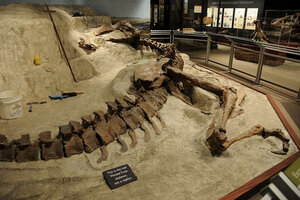Nearly complete T. rex skeleton to join Smithsonian collection
Crates containing the Wankel T. rex have arrived at the Smithsonian National Museum of Natural History in Washington, shipped from the Museum of the Rockies, in Bozeman, Mt., near where it was first discovered in 1988.

The real Wankel T.rex is prepared for exhibit in its original “death pose” at Montana State University’s Museum of the Rockies, Bozeman, Mont., 2005. The Wankel T.rex died in a riverbed more than 65 million years ago.
Photo courtesy Museum of the Rockies
Joining a diverse roster of iconic American objects from Judy Garland's ruby slippers to the space shuttle Discovery, a nearly complete T. rex skeleton was welcomed to the Smithsonian this morning (April 15).
The dinosaur is on loan to the Smithsonian's National Museum of Natural History for at least the next 50 years. Split up into many crates, the bones arrived in Washington, D.C., this week after a road trip from the Museum of the Rockies in Bozeman, Mont., the fossil's former home near the badlands where the skeletal remains were found.
The Smithsonian National Museum of Natural History, which opened more than a century ago, has 46 million fossils in its collection, but this new addition is its first near-complete T. rex. [Photos: The Near-Complete Wankel T. Rex]
"We could not be more excited to welcome the Nation's T. rex to Washington so it can be enjoyed by our 8 million visitors a year and serve as a gateway to the vast world of scientific discovery," Kirk Johnson, director of the National Museum of Natural History, said in a statement.
Tyrannosaurus rex roamed North America some 68 million to 66 million years ago. It was one of the largest known carnivorous dinosaurs and one of the last non-avian dinosaurs to walk the Earth prior to the Cretaceous-Paleogene extinction event. Legendary fossil hunter Barnum Brown discovered the first T. rex bones in Montana in 1902 at the Hell Creek Formation.
The Smithsonian is now referring to the fossil as "the Nation's T. rex," though it previously had been known as the Wankel T. rex after Kathy Wankel, a rancher who first spotted the dinosaur's arm bones poking out of the earth near Montana's Fort Peck reservoir in 1988. A team of paleontologists led by Jack Horner exposed the rest of the skeleton during subsequent excavations. The dinosaur bones belong to the U.S. Army Corps of Engineers as they were discovered on federal lands.
The Smithsonian will close its fossil hall on April 27 for a $48 million renovation, expected to be completed in 2019. The new hall will be named after billionaire David H. Koch, the oil and gas magnate who donated $35 million to the project.
So that visitors can enjoy the new T. rex during the five-year renovation, on Tuesday the museum opened a "Rex Room," where people will be able to see staff members unpack, catalog, photograph and scan the 66-million-year-old bones, Smithsonian officials said.
The museum also plans to display other dinosaur fossils through exhibitions while work on the hall is underway. A show called "The Last American Dinosaurs: Discovering a Lost World," opening Nov. 25, will tell the story of the final days of dinosaurs found in the Hell Creek Formation.
Follow Megan Gannon on Twitter and Google+. Follow us @livescience, Facebook & Google+. Original article on Live Science.
- Image Gallery: The Life of T. Rex
- In Photos: Montana's Dueling Dinosaur Fossils
- 5 Fossil Hotspots: National Parks to Visit
Copyright 2014 LiveScience, a TechMediaNetwork company. All rights reserved. This material may not be published, broadcast, rewritten or redistributed.

